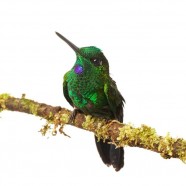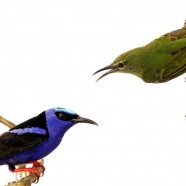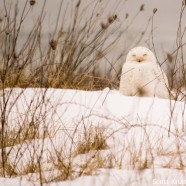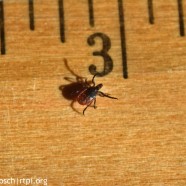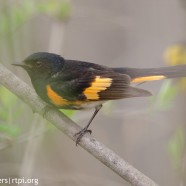Green-crowned Brilliant (Heliodoxa jacula)
Here is the Green-crowned Brilliant (Heliodoxa jacula), a large hummingbird commonly found at higher elevations in Costa Rica. It can be seen on edge clearings and in the forest, protecting certain feeding plants. This is an adult male, as juveniles usually have a mix of green and white plumage with a orange gorget. It turns purple as it ages, and as you can see by the full purple gorget this is indeed an adult male. Photographed by RTPI Affiliate Sean Graesser for the Meet Your Neighbours global biodiversity project in Costa Rica while on assignment for the Roger Tory Peterson Institute of...
Read MoreRed-legged Honeycreeper (Cyanerpes cyaneus)
Here we have the vibrant male and subtle female Red-legged Honeycreeper (Cyanerpes cyaneus). You can see the contrast in plumage between the breeding male and green female, and non-breeding and juvenile males also have green plumage. It is a common species in mixed feeding flocks on forest edges. Photographed by RTPI Affiliate Sean Graesser for the Meet Your Neighbours global biodiversity project in Costa Rica while on assignment for the Roger Tory Peterson Institute of Natural History.
Read MoreSleepy Snowy Owl
I recently found this Snowy Owl (Bubo scandiacus) taking a snooze on a cloudy and dreary sort of morning, sitting in the snow in some grasslands, blending in well with its surroundings. This bird looks to be an adult male with an almost all-white head and body. Despite how sleepy it was it stayed on guard, a silent and barely-moving sentinel occasionally turning its head to check something out with eyes still nearly entirely shut. There are still plenty of these visitors around, and soon enough they will be moving back to the north. Get out and find one! Scott Kruitbosch Conservation &...
Read MoreCool mornings, warm bodies
Here’s an adult female deer tick that I photographed yesterday on this ruler (inches). They are actually rather large compared to young ticks, or nymphs. I pulled another one off my dog this morning. If you live near or frequent an area or habitat prone to ticks be aware that at this time of year the cool autumn mornings can lead these parasites to find any warm body they can, leaping on to mammals quickly. Thankfully you should be able to spot them if you check carefully.
Read MoreAmerican Redstart
Adult male American Redstarts (Setophaga ruticilla) like this one are such a symbol for the season to me. Yes, I can hear their spring song in my mind, especially after seeing so very many in the Chautauqua-Allegheny region this year. Nevertheless, they were usually one of the first and most obvious migrants I saw in late August and September each year when I was a beginning birder, getting me excited for a busy fall migration. Their Halloween tone around the beautifully decaying vegetation helps, too.
Read More



